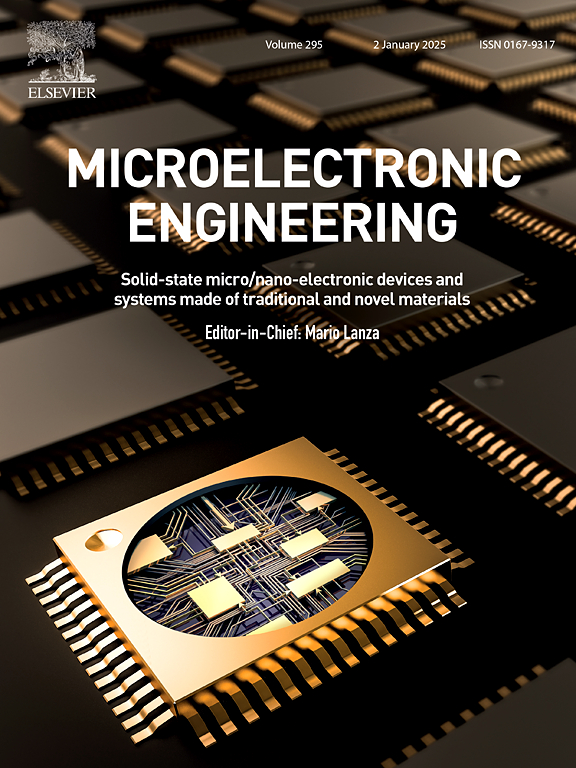On the time series analysis of resistive switching devices
IF 3.1
4区 工程技术
Q2 ENGINEERING, ELECTRICAL & ELECTRONIC
引用次数: 0
Abstract
Resistive switching (RS) based memory or memristive devices have emerged as promising candidates for resistive random-access memory (RRAM) and neuromorphic computing applications. However, the integration of RS devices into commercial production faces significant challenges due to substantial variations in RS parameters, which include cycle-to-cycle (C2C) and device-to-device (D2D) fluctuations. In this context, we propose a multivariate time series analysis framework to investigate the variability exhibited by RS devices. We present a detailed description of the statistical methodology and procedures for conducting both univariate and multivariate time series analysis, along with recommended tests and protocols. Specifically, we focus on utilizing Ti3C2 MXene oxide-based RS devices as a case study for this analysis. Our findings reveal that employing the multivariate method yields superior prediction results compared to the univariate approach. This conclusion is based on our observation that the Vector Autoregressive Moving Average (VARMA) model, which concurrently considers multiple variables (VSET and VRESET), more effectively explains a larger portion of the variability in the data compared to the univariate model. This underscores the importance of considering multiple factors simultaneously, as it provides a more comprehensive understanding of the underlying patterns within the dataset, thereby enhancing the accuracy of predictions. Consequently, we advocate for adopting the multivariate approach due to its ability to capture the complexity and interactions inherent in the dataset, resulting in enhanced model performance. The proposed model demonstrated superior performance in capturing the variability present in VSET and VRESET data, thereby producing the most optimal outcomes.

电阻开关器件的时间序列分析
基于电阻开关(RS)的存储器或记忆器件已成为电阻随机存取存储器(RRAM)和神经形态计算应用的有前途的候选者。然而,由于RS参数的巨大变化,包括周期到周期(C2C)和设备到设备(D2D)的波动,RS设备融入商业生产面临着重大挑战。在这种情况下,我们提出了一个多变量时间序列分析框架来研究RS设备所表现出的可变性。我们详细介绍了进行单变量和多变量时间序列分析的统计方法和程序,以及推荐的测试和协议。具体来说,我们将重点放在利用基于Ti3C2 MXene氧化物的RS器件作为本分析的案例研究上。我们的研究结果表明,与单变量方法相比,采用多变量方法可以产生更好的预测结果。这一结论是基于我们的观察,即同时考虑多个变量(VSET和VRESET)的向量自回归移动平均(VARMA)模型,与单变量模型相比,更有效地解释了数据中更大一部分的可变性。这强调了同时考虑多个因素的重要性,因为它提供了对数据集中潜在模式的更全面的理解,从而提高了预测的准确性。因此,我们提倡采用多变量方法,因为它能够捕获数据集中固有的复杂性和交互,从而提高模型性能。该模型在捕获VSET和VRESET数据中的可变性方面表现出优异的性能,从而产生最优的结果。
本文章由计算机程序翻译,如有差异,请以英文原文为准。
求助全文
约1分钟内获得全文
求助全文
来源期刊

Microelectronic Engineering
工程技术-工程:电子与电气
CiteScore
5.30
自引率
4.30%
发文量
131
审稿时长
29 days
期刊介绍:
Microelectronic Engineering is the premier nanoprocessing, and nanotechnology journal focusing on fabrication of electronic, photonic, bioelectronic, electromechanic and fluidic devices and systems, and their applications in the broad areas of electronics, photonics, energy, life sciences, and environment. It covers also the expanding interdisciplinary field of "more than Moore" and "beyond Moore" integrated nanoelectronics / photonics and micro-/nano-/bio-systems. Through its unique mixture of peer-reviewed articles, reviews, accelerated publications, short and Technical notes, and the latest research news on key developments, Microelectronic Engineering provides comprehensive coverage of this exciting, interdisciplinary and dynamic new field for researchers in academia and professionals in industry.
 求助内容:
求助内容: 应助结果提醒方式:
应助结果提醒方式:


